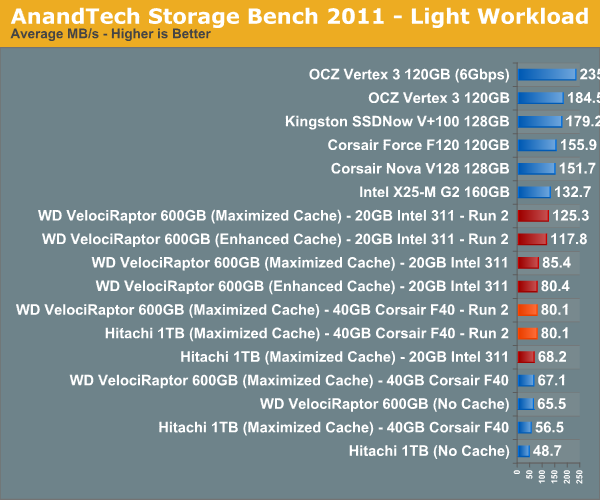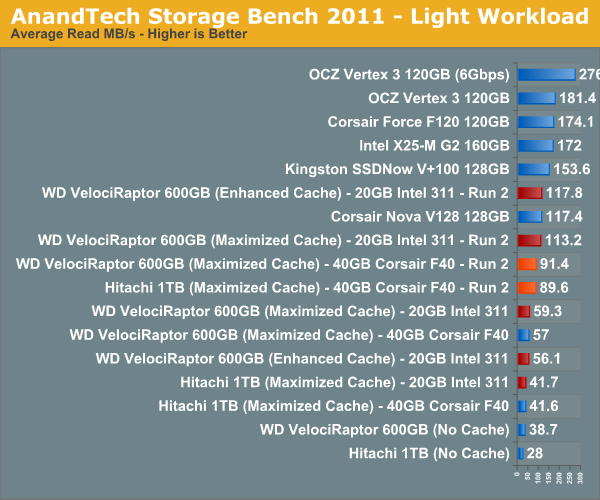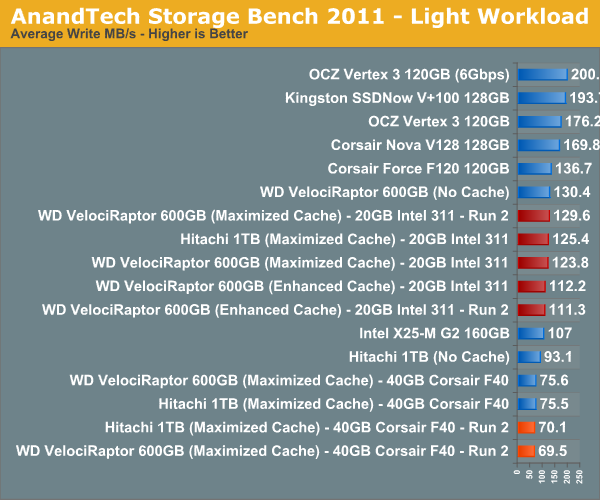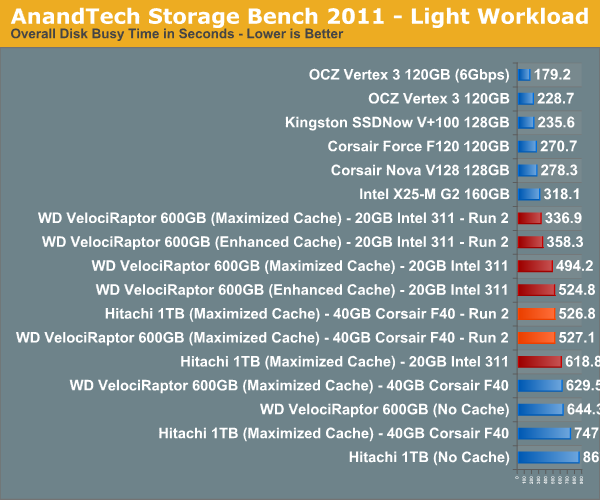Z68 SSD Caching with Corsair's F40 SandForce SSD
by Anand Lal Shimpi on May 13, 2011 3:06 AM ESTAnandTech Storage Bench 2011 - Light Workload
Our new light workload actually has more write operations than read operations. The split is as follows: 372,630 reads and 459,709 writes. The relatively close read/write ratio does better mimic a typical light workload (although even lighter workloads would be far more read centric).
The I/O breakdown is similar to the heavy workload at small IOs, however you'll notice that there are far fewer large IO transfers:
| AnandTech Storage Bench 2011 - Light Workload IO Breakdown | ||||
| IO Size | % of Total | |||
| 4KB | 27% | |||
| 16KB | 8% | |||
| 32KB | 6% | |||
| 64KB | 5% | |||
Despite the reduction in large IOs, over 60% of all operations are perfectly sequential. Average queue depth is a lighter 2.2029 IOs.

Our light workload doesn't do very well on the F40 at all. As we discovered in our launch review, the heavy workload runs for long enough (~3 hours) that performance doesn't change from run to run. Our light workload however only takes around 30 - 45 minutes to run and thus we see a significant performance difference from one run to the next (after 2 runs the performance gains level off though). While the Intel SSD 311 climbs significantly in both runs, the F40 shows a marginal improvement in the first run and tops out at around 80MB/s regardless of what HDD it's paired with. Clearly we're hitting a bottleneck here, one that doesn't exist on the 311.
An obvious benefit of Intel's SSD 311 is that its firmware was designed with caching in mind, something that isn't true for standard SSDs used as a cache.















81 Comments
View All Comments
hechacker1 - Friday, May 13, 2011 - link
Agreed. I wonder if anybody can hack the RST 10.5 driver to make it work on any intel chipset.I actually just modded my X58 bios to include the new Intel Raid option rom, version 10.5.0.744. Guess what? The Acceleration Options shows up in the raid bios.
Unfortunately, I don't have an SSD to see if it will work.
I also tried an even newer option rom, and that Acceleration Option is now grayed out...
Either way, this is just software it seems.
Anandtech, any idea if the z68 chipset has some hardware responsible for enabling cache?
mianmian - Friday, May 13, 2011 - link
The write frequency on the catching drive is much more frequent than a normal disk. MLC might not have enough endurance to survive long under this kind of load.Shadowmaster625 - Friday, May 13, 2011 - link
I would rather just manage two drives, and move whatever I'm not using over to the media drive. It's not that hard; it only takes a couple clicks to move a folder from drive C to drive E. And for people who are scared to death of performing such types of operations, I doubt they'd see a reason to justify an extra $100. They can just suffer with a single drive solution. At least until the SSD cache is reduced to no more than a $20-$40 premium. I still think an integrated flash controller and a SSD DIMM is the way to go, and intel is shooting themselves in the foot with this half*** solution. A 10 channel SSD controller built into the cpu would be so blazingly fast...qwertymac93 - Friday, May 13, 2011 - link
Hmm, price of 40gig Corsair force = $110Price of 60gig vertex 2 = $105
... Am i missing something here?
cactusdog - Friday, May 13, 2011 - link
The features of this platform sounded great on paper but in reality a bit of a letdown.For people with a SSD this caching thing is useless.
I'm guessing AMD/Nvidia's next gen cards will have a quicksinc like performance built into their gpus, making sandy bridge/Quicksinc not so attractive.
Sata 6GBs is nice but anyone can get that speed on older boards with a pci-e ssd or just RAIDing 2 SSDs.
The only really attractive thing is unlocked CPUs for a reasonable pric but. I'm gonna skip this platform........ by the end of the year this platform will look very average.
assafb - Friday, May 13, 2011 - link
1) A more useful configuration would have been the SandForce 40GB on Enhanced mode, but it has only been tested as maximized?2) A power user would use an SSD as the boot drive naturally, SSD caching alone would be inferior, of course, but that is not all that there is to it with SSD caching for the power user. This is the question - whether the 160GB mainstream SSD buyer that has a mainstream 2TB HD would be better off with a 160GB boot drive and no caching, or with 40GB partitioned out of his 160GB SSD to cache the HD and the remaining 120GB partition for the boot drive and critical apps. This question is relevant as for many users like myself, OS+apps+games exceed 160GB, and even the unaffordable 256GB+ SSDs, so some apps and games still have to get to the mechanical HD.
Anand Lal Shimpi - Friday, May 13, 2011 - link
1) Enhanced mode should perform similarly to maximized mode in read performance. Write performance should be lower, at least on the Hitachi drive.2) If you can fit your OS and apps on the 120GB partition, then the 120/40 setup is your best bet for tackling games in my opinion.
Take care,
Anand
assafb - Saturday, May 14, 2011 - link
Thanks!sparky0002 - Friday, May 13, 2011 - link
Go for broke. Build the quickest array you can behind a z68 chipset then throw a cache infront of it. It would suck if it ended up as the limit rather than as a booster. My guess is enhanced mode will perform better.but what I really want to know is... I've lived my life inside a 60gb partition for years. Games and the like are on another disk. so how would three SSD 311's in raid 0 V's a Revodrive go? No cache just a straight test of the SLC drives.
don_k - Saturday, May 14, 2011 - link
'so how would three SSD 311's in raid 0 V's a Revodrive go'Not even close. The first gen revodrive does 500MB/s read/writes. Second gen doubles those numbers. So three 311 would give you maybe ~300MB/s at a higher price than a first gen revodrive.